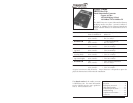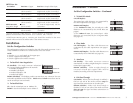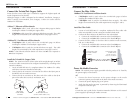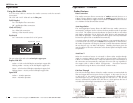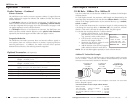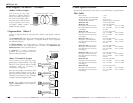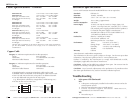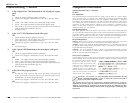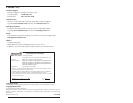
10
SBFTF10xx-10x
24-Hour Technical Support: 1-800-260-1312 -- International: 00-1-952-941-7600
Half-Duplex Network -- Continued
100Base-TX Fiber Example
The drawing to the right
illustrates a collision domain
where two media converters
are connected via fiber cable.
Since the total of the bit-times
in this example is less than
512 (50BT + 400BT + 50BT =
500BT) the path is good.
5-Segment Rule - 10Base-T
Use the 5-Segment Rule to calculate the 10Base-T half-duplex collision
domain.
The 5-Segment rule states that a transmission path of a collision domain can
consist of no more than 5 segments. A “collision domain” and a “segment”
are defined as follows:
A collision domain is the longest path in a 10Base-T network between any
two terminal devices, e.g. a terminal, switch, or router. The SBFTF10xx-10x
media converter is also a terminal device.
A segment is a cable connection
between any two network interfaces
within a collision domain.
10Base-T Twisted-Pair Example
The example to the right illustrates
applying the 5-Segment Rule. The cable
between each network device (media
converter, Hub, or Terminal) is
numbered as a “segment”.
Note that the longest transmission path
(from the media converter at the top to
the terminal at the bottom) is 5 segments.
Therefore, the network in this example
complies with the 5-Segment Rule.
NOTE: The 5-Segment Rule must be
applied separately to each 10Base-T
collision domain.
hub
3
4
5
2
hub
3
4
2
1
hub
hub
100 meters TP
straight-through
100 meters TP
straight-through
100 meters TP
straight-through
100 meters TP
straight-through
media converter
100 meters TP
cross-over
100 meters TP
cross-over
100 meters TP
cross-over
100 meters TP
cross-over
media converter
= 50BT
media converte
r
= 50BT
400 meters fiber cable = 400BT
techsupport@transition.com -- Click the “Transition Now” link for a live Web chat.
11
Cable Specifications
The physical characteristics must meet or exceed IEEE 802.3™ specifications.
Fiber Cable
Bit Error Rate: <10-9
single mode fiber (recommended): 9 µm
Multimode fiber (recommended): 62.5/125 µm
Multimode fiber (optional): 100/140, 85/140, 50/125 µm
SBFTF1011-100 1300 nm multimode
SBFTF1013-100 1300 nm multimode
Fiber Optic Transmitter Power: min: -19.0 dBm max: -14.0 dBm
Fiber Optic Receiver Sensitivity: min: -30.0 dBm max: -14.0 dBm
Link Budget: 11.0 dB
SBFTF1014-100 1310 nm single mode
Fiber-optic Transmitter Power: min: -15.0 dBm max: -8.0 dBm
Fiber-optic Receiver Sensitivity: min: -31.0 dBm max: -8.0 dBm
Link Budget: 16.0 dB
SBFTF1015-100
(long haul)
1310 nm single mode
Fiber-optic Transmitter Power: min: -8.0 dBm max: -2.0 dBm
Fiber-optic Receiver Sensitivity: min: -34.0 dBm max: -7.0 dBm
Link Budget: 26.0 dB
SBFTF1016-100
(extra long haul)
1310 nm single mode
Fiber-optic Transmitter Power: min: -5.0 dBm max: 0.0 dBm
Fiber-optic Receiver Sensitivity: min: -34.0 dBm max: -7.0 dBm
Link Budget: 29.0 dB
SBFTF1017-100
(long wave length)
1550 nm single mode
Fiber-optic Transmitter Power: min: -5.0 dBm max: 0.0 dBm
Fiber-optic Receiver Sensitivity: min: -34.0 dBm max: -7.0 dBm
Link Budget: 29.0 dB
SBFTF1018-100 1300 nm multimode
Fiber-optic Transmitter Power: min: -19.0 dBm max: -14.0 dBm
Fiber-optic Receiver Sensitivity: min: -33.5 dBm max: -14.0 dBm
Link Budget:
SBFTF1019-100 1310 nm single mode
Fiber-optic Transmitter Power: min: -15.2 dBm max: -8.0 dBm
Fiber-optic Receiver Sensitivity: min: -32.5 dBm max: -3.0 dBm
Link Budget: 17.3 dB



